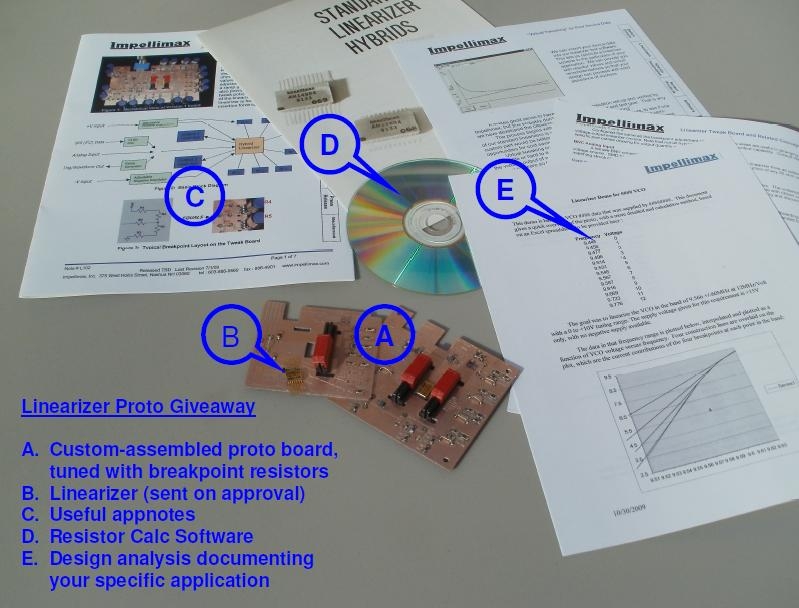Free Linearizer Set-up Service, Software, and Evaluation Board, and Design Report.
Please contact Impellimax to receive your Free Linearizer Giveaway.
- Linearizer Design Guide 12 pg, covers Linearizer applications in Driving PIN and GaAs MMIC Attenuators, Linearizing Varactors, etc. Rev A, 5MB
- L100 Binary Input Dual-Output Linearizer for GaAs MMICs (22KB) rev 10/1/97
- L102 Linearizer Tweak Board (Appnote L102 is currently being drafted. Please contact the factory for any assistance you may need in dealing with your Linearizer requirements.)
- Linearizer Demo for VCO (161KB) 4pg PDF 10/30/09

We will select the most applicable linearizer for your requirement, attach the correct curve-setting resistors, verify the performance of the circuit, and provide you with all of the hardware and a report showing you how the design was done so you can do it again.
When your hardware and report arrives, you should be able to connect it to power supplies, attach the input and output, and see immediate results in your system.
If you like the results, keep the hardware and we will bill you only for the linearizer hybrid, payable 60 days after the date of delivery. The design report, evaluation board, and software are free. If, for any reason, you prefer to return the linearizer hybrid in good mechanical condition within the first 30 days, you will not be billed at all and you may keep the eval board and software for free. Additionally, further consultation, explanation and application support is always just a phone call or an email away.
This offer is valid until 9/30/2011. We would like to show you just how simply your transfer function design requirements can be met, using Impellimax Standard Linearizers.
What is a Linearizer ?
A linearizer is a unique component that can translate a tuning curve into another shape. Impellimax Linearizers incorporate tight transistor matching and thermal tracking, to provide a smoothly transitioning breakpoint linearization that can output as a current source or a voltage, depending on the external connection. The input impedance is typically greater than 10Kohms.
A few examples will clarify what a Linearizer is:
- Example 1: PIN diode shunt attenuator.
You will typically find that the first 10dB happens with just a few microamps of diode current, but to get the last 10 db (say, from 50dB to 60dB) might take tens of milliamps. Still, for your system spec you need it to behave linearly, so that for example it moves 10dB per volt over a 6 volt range. Using an Impellimax AP17UA2 linearizer in this example would give you an output current that starts off very slowly (over the first 10 dB, in this example) but the tuning rate increases smoothly such that the last volt of tuning (from 5 to 6 volts) causes the output current of the linearizer to vary by the requisite tens of milliamps. Seven breakpoints in the tiny linearizer allow close curve-fitting to the specific required curve of your attenuator. - Example 2: PIN diode series attenuator.
For linear tuning, the requirements of the linearizer are exactly the opposite of the shunt attenuator example given above. Specifically, the first 10dB may require a change of tens of milliamps, while the higher attenuation states all happen within the last few microamps. For this, an Impellimax AN17DA2 provides the concave-down transfer function and negative output current that is required. - Example 3: PIN diode series/shunt attenuator.
To simultaneously tune a series diode and a set of shunt diodes, you can either use two separate linearizers, as described in the two examples above, or a single AM17SA4, which combines an AP1 and an AN1 linearizer in one package for convenience. - Example 4: Varactor Voltage-Controlled Oscillator.
Varactor diodes are tuned using a reverse voltage that alters the capacitance of the junction. Impellimax AP17UA2 linearizers, set for voltage output mode, typically fulfill this function for VCO tuning curves up to +18V. For varactor tuning curves up to 40V or even 100V, higher voltage grade linearizers are available to satisfy the requirement. - Example 5: Sensor Linearization.
Some chemical sensors, optical position sensors, and the like produce an output signal that is not the desired response to stimulus. Even if the output curve is S-shaped, an Impellimax Linearizer can provide a combination of “cut” and “boost” breakpoints such that complicated transfer functions such as “S”, “C”, or “double-hump” can be linearized quite easily. - Example 6: Temperature Compensating Circuits for Complex Systems.
Impellimax Linearizers provide a simple method to improve the performance of your products over temperature. The concept is that at any given temperature, there usually exists an optimum operating or tuning voltage that, if applied, would improve the overall functioning of your RF or Microwave system. This optimizing supply can be delivered by an Impellimax temperature-compensating linearizer. It does not matter if the optimizing voltage has a complicated temperature vs voltage characteristic. S-curves, concaves, convexes, and straight line transfer functions are all easily synthesized. These hybrids can provide low-level adjustments, such as gate voltage tweaking, or high current adjustments, such as drain or Vsupply adjustment capable of several amperes, or high voltage temperature compensation, such as tuning voltage on a varactor.
The process starts with measured data points of your unit over temperature, where you manually adjust the parameter to produce optimum results at each step in a set of temperatures. Impellimax will then work with your data points and provide a hybrid and/or pcb solution that can drop in and produce the required temperature-dependent optimizing voltage or current automatically.
Impellimax temp-comp circuits are entirely analog, with smooth transitions in the temperature vs output transfer function. This is a critically important feature, since most systems cannot tolerate the discontinuous jumps that are inherent in ROM look-up tables, for example. With Impellimax temperature-compensating circuits, a change in temperature always results in a smooth change of optimizing output.
Multi-output compensators can also be created, provided more than one correcting voltage or current to simultaneously optimize your system in more complete ways.




